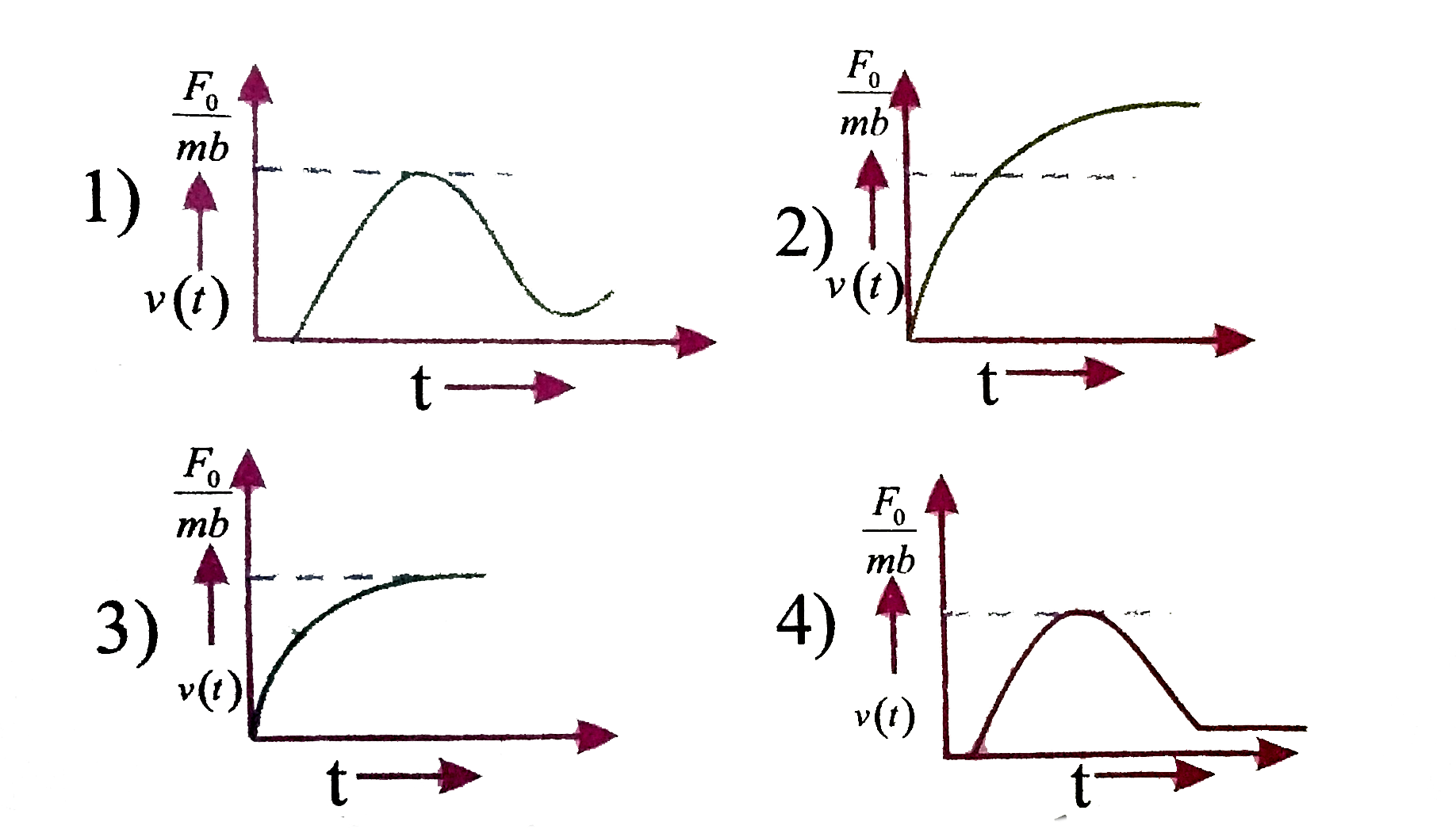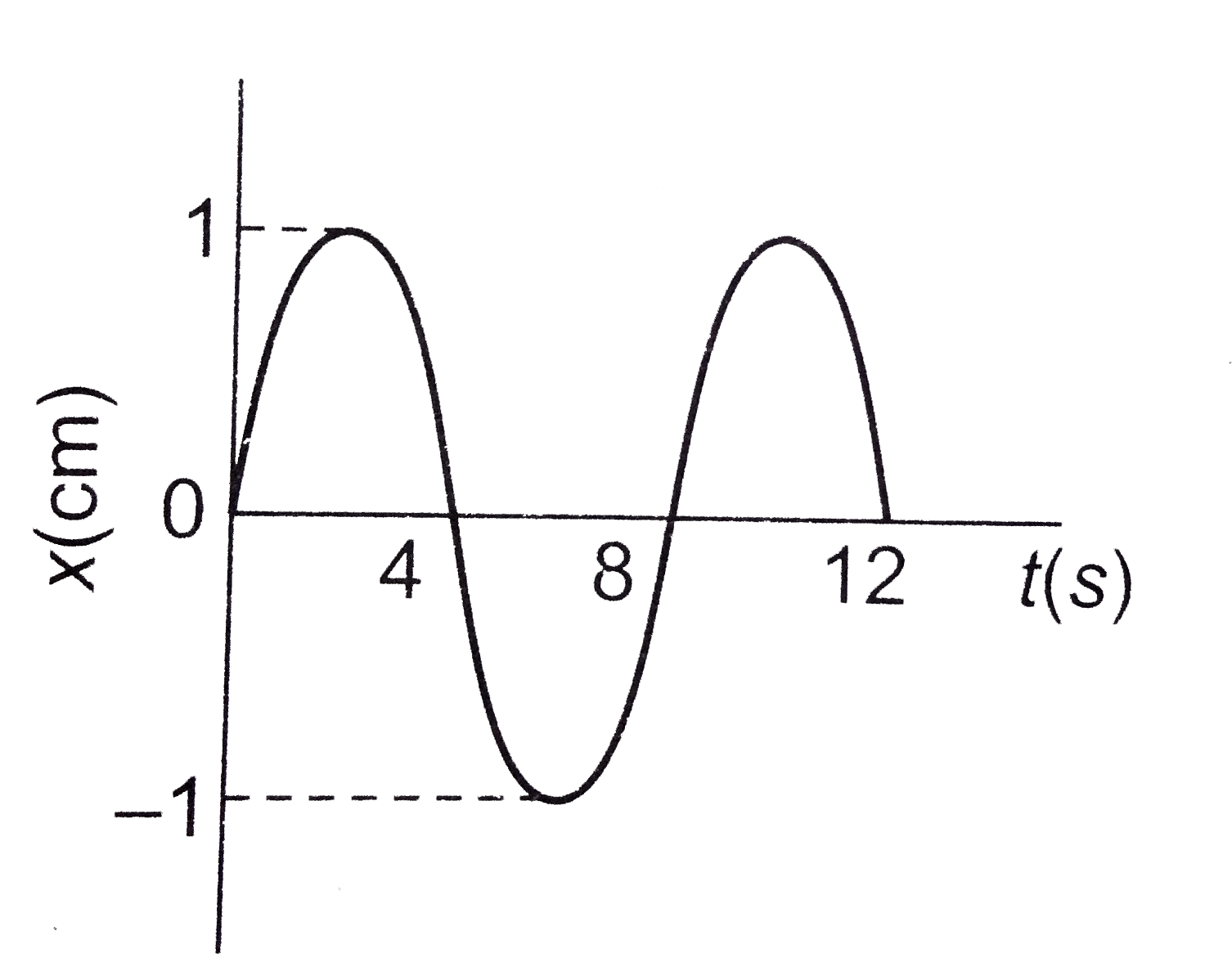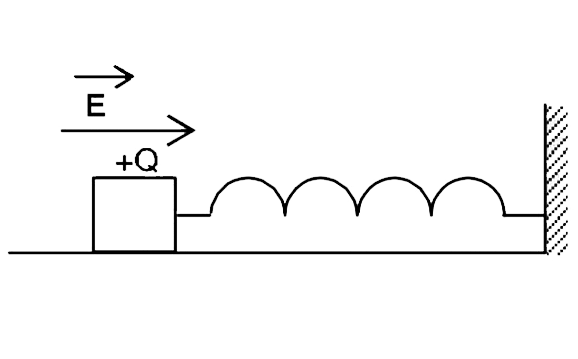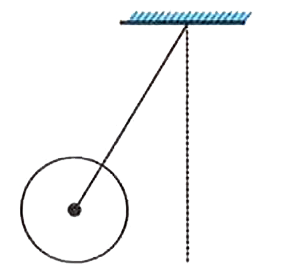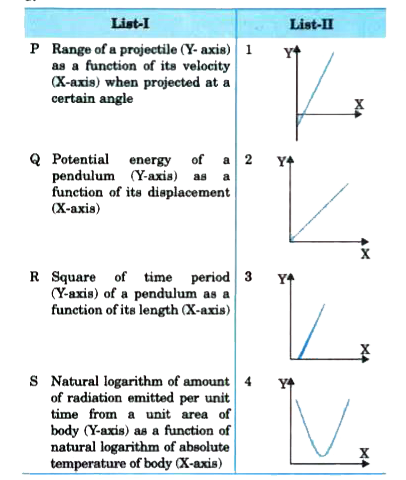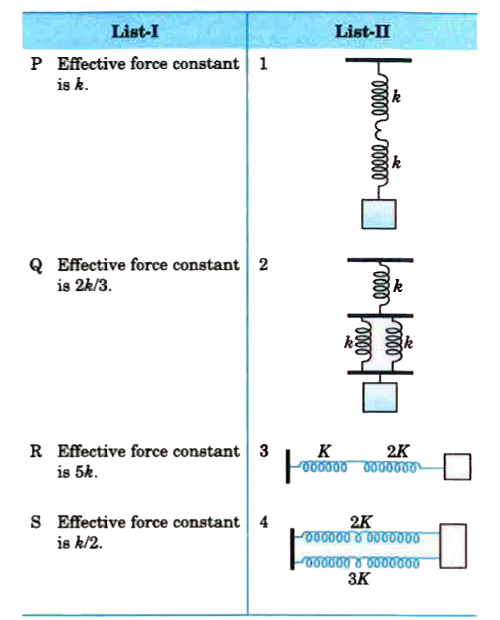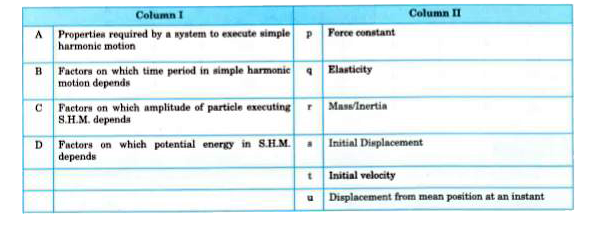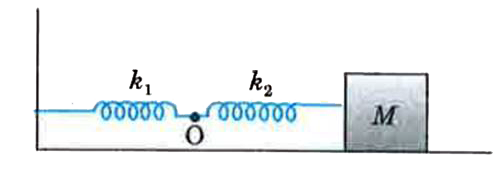Competition File (Matching Type Questions) from MODERN PUBLISHERS PHYSICS (HINGLISH) OSCILLATIONS for Class 11
| Class 11 | PHYSICS |
| Chapter | OSCILLATIONS |
| MODERN PUBLISHERS PHYSICS (HINGLISH) | Competition File (Matching Type Questions) |
| Medium | English |
| Academic Year | 2023-2024 |
Question 4
The arrangement shown of a uniform rod of length l and mass m, pivoted at the centre and its two ends attached to two springs of spring constant K1 and K2 . The other end of springs are fixed to two rigid supports the rod which is free to rotate in the horizontal plane , is pushed by a small angle in one direction and released . Teh frequency of oscillation of the rod is
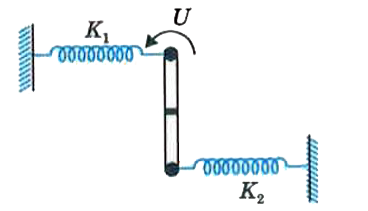 View Solution
View SolutionQuestion 5
The arranghement shown in the figure below consits of a block of mass 0.1 kg attached to a spring of force cosntant 2×10−3N/M with the help of a pulley so that the spring remians unstretched.On releasing the block , it starts oscillating with a small amplitude . The maximum velocity of block during this motion is close to View SolutionQuestion 7
The young modulii of two springs of equal length and equal cross sectional areas are in the ratio 2:3 both the springs are suspended and loaded with the same mass . When springs are stretched and released , the time period of oscillation of the two springs is in the ratio of View SolutionQuestion 10
Form the centre of a large concave mirror of radius of curvature 3 sm , a small sperical steel ball is placed at a little distance on the mirror itself . The ball is then released to execute oscillatory motion on the mirror . The time period of motion of the ball is
(Neglect friction and take g=10ms2View SolutionQuestion 14
A small block of mass m is attached to free end of a spring of force cosntant k , whose other end is fixed to a rigid support . The block is lying on a frictionless horizontal plane and it starts movi0ng away from fixed end of the spring a\t t= 0 with intial velocity u When the speed of the block is 0.6μ it collides with a fixed heavy mass elastically. After the collision with a fixed heavy mass elastically . Aftere the collision the time at which the block passes through its equilibrium position for the first time is close to View SolutionQuestion 19
The arrangement shown below shows a block of mass M and m, with a spring of force constant k attached to the spring fixed to the wall . What will be the maximum value of frictional force between them if μ is the coefficient of friction and the blocks move together in S.H.M with amplitude A ?
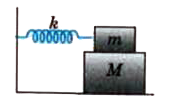 View Solution
View SolutionQuestion 27
A mass falls from a height h and its time of fall t is recorded in terms of time period T of a simple pendulum. On the surface of earth it is found that t=2T.The entire sete up is taken on the surface of another planet whose mass is half of that of earth and raidus the same experiment is repeated and corresponding times noted as t' and T'
Then we can say View SolutionQuestion 28
A mass of 2.0kg is put on a flat pan attached to a vertical spring fixed on the ground as shown in figure. The mass of the spring and the pan is negligible. When pressed slightly and realeased the mass executes a simple contant is 200N/m. What should be the minimum amplitude of the motion, so that the mass gets the detached from the pan? (Takeg=10m/s2)
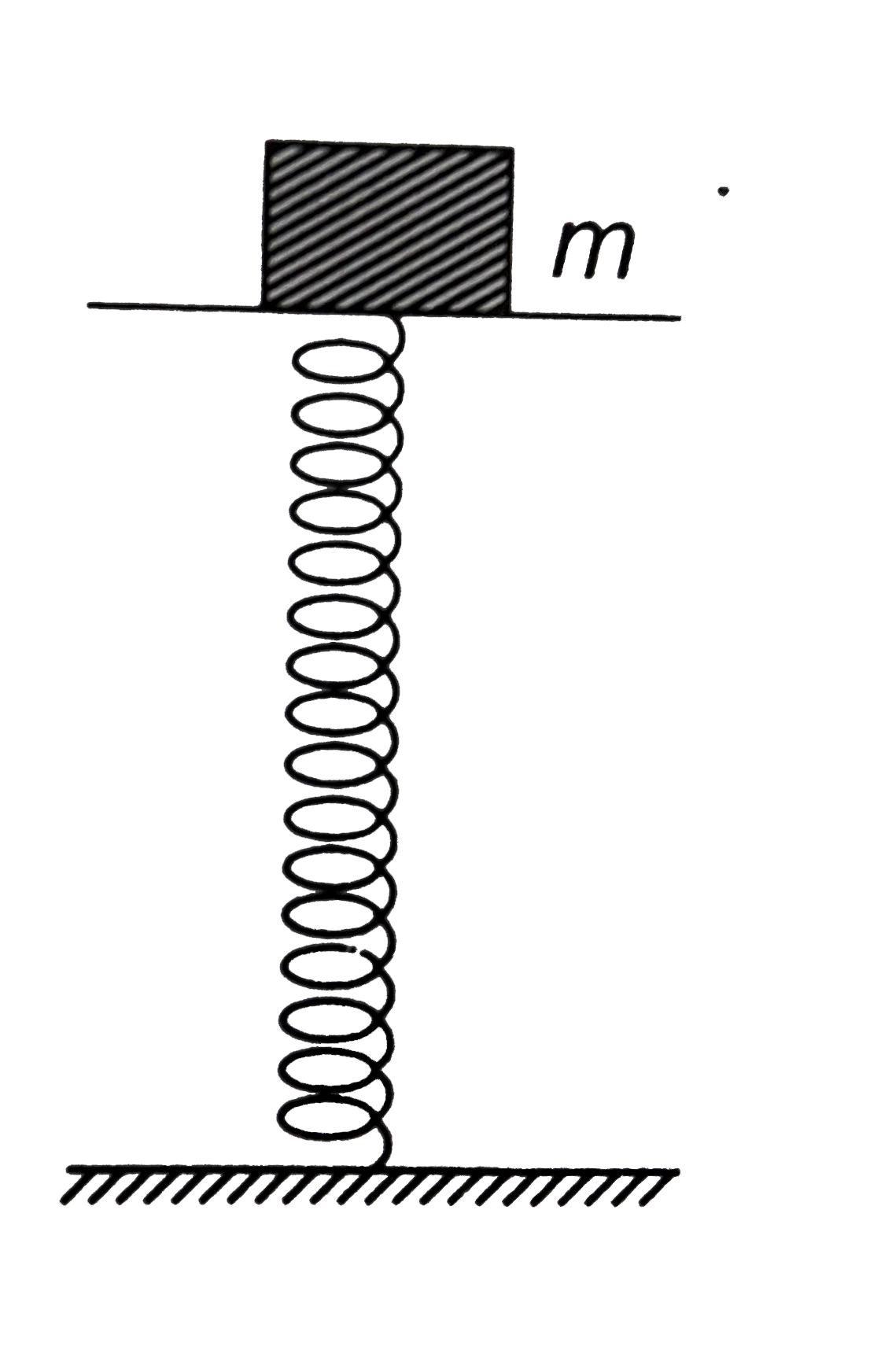 View Solution
View SolutionQuestion 35
Two masses m and m2 are connected at the two ends of a massless rigid rod of length l. The rod is suspended by a thin wire of torsional constant k at the centre of mass of the rod-mass system(see figure). Because of torsional constant k, the restoring torque is τ=kθ for angular displacement θ. If the rod is rotated by θ0 and released, the tension in it when it passes through its mean position will be :
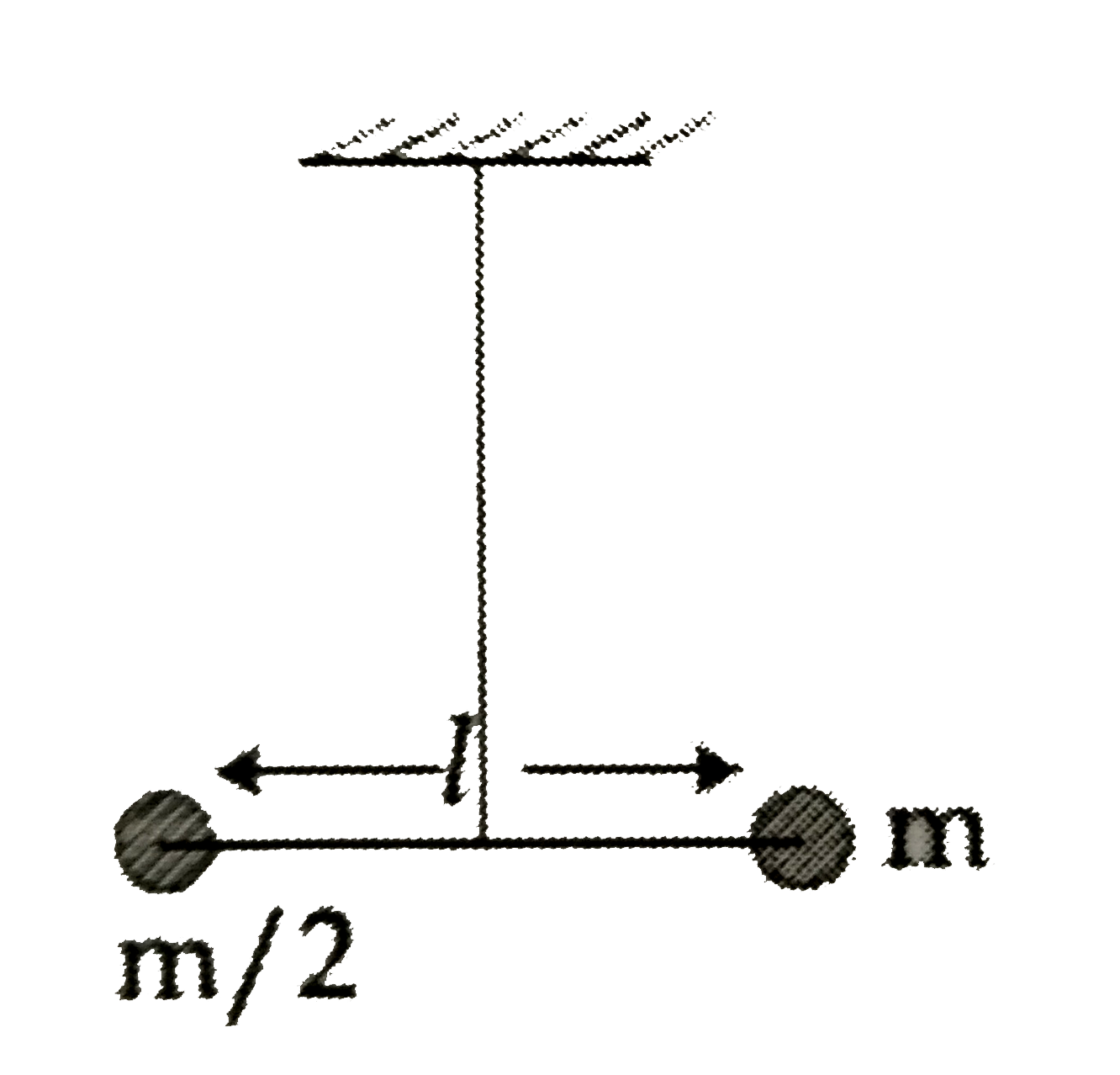 View Solution
View SolutionQuestion 38
A rod of mass 'M' and length '2L' is suspended at its middle by a wire. It exhibits torsional oscillations, if two masses each of 'm' are attached at distance'L/2' from its centre on both sides, it reduces the oscillation frequency by 20%. The value of ratio m/M is close to :View SolutionQuestion 40
A massless spring (k = 800 N/m), attached with a mass (500 g) is completely immersed in 1 kg of water. The spring is stretched by 2 cm and released so that it starts vibrating. What would be the order of magnitude of the change in the temperature of water when the vibrations stop completely? (Assume that the water container and spring receive negligible heat and specific heat of mass = 400 J/kg K, specific heat of water = 4184 J/kgk)View SolutionQuestion 43
If a simple pendulum has significant amplitude (up to a factor of1//e of original) only in the period between t−0s→t=τs, then τ may be called the average life of the pendulum. When the sphetical bob of the pendulum suffers a retardation (due to viscous drag) proportional to its velocity with b as the constant of propotional to average life time of the pendulum is (assuming damping is small) in seconds:View SolutionQuestion 45
An ideal gas enclosed in a cylindrical container supports a freely moving piston of mass M. The piston and the cylinder have equal cross-sectional area A. When the piston is in equilibrium, the volume of the gas is V0 and its pressure is P0. The piston is slightly displaced from the equilibrium position and released. Assuming that the system is completely isolated from its surrounding, the piston executes a simple harmonic motion with frequency View SolutionQuestion 51
Two particles are executing SHM in a straight line. Amplitude A and the time period T of both the particles are equal. At time t=0, one particle is at displacement x1=+A and the other x2=(−A2) and they are approaching towards each other. After what time they across each other? T4View SolutionQuestion 54
If an experiment to determine the period of a simple pendulum of length 1m , it is attached to different spherical bobs of raddi r1 abd r2. The two spherical bobs have uniform mass distribution . If the relative difference in the periods mass distribution.. If the relative differene in the periods is found to be 5×10−4s, the difference in radii |r1−r2| is best given by View SolutionQuestion 60
Student I, II and III perform an experiment for measuring the acceleratioon due to gravity (g) using a simple pendulum . Theu use different lengths of the pedulum and /or record time for different number of oscillations . The observation are shoen in the table .
Least count for length =0.1cm
Least count for time =0.1s
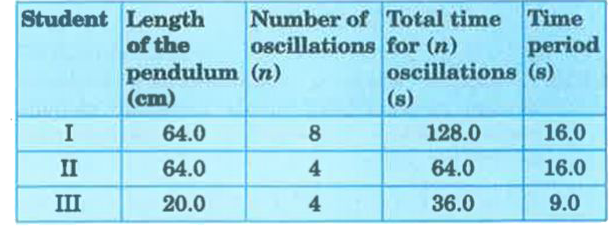
If EI, EIIand EIIIare the percentage errors in g,i.e
Δgg×100for students I, II, and III respectively , View SolutionQuestion 61
A block (B) is attached to two unstriched sprig S1 and S_(2) with spring constant K and 4K , respectively (see fig 1) The other ends are atteched in identical support M1 and M2 not attached in the walls . The springs and supports have negligible mass . There is no friction anywhere . The block B is displaced toword wall 1 by a small distance z (figure (ii)) and released . THe block return and moves a maximum displacements x and y are musured with reoact to the equalibrum of the block B and the ratio y/x is
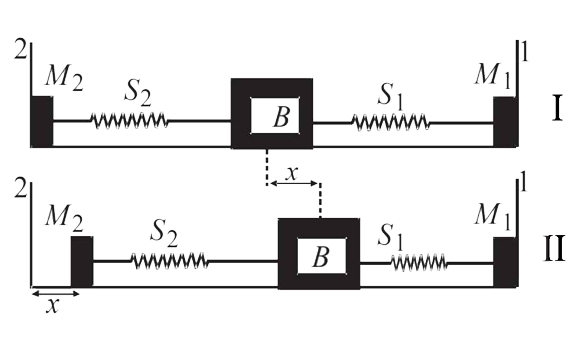 View Solution
View SolutionQuestion 64
A uniform rod of length L and mass M is pivotedat the centre. Its two ends are attached to two springs of equal spring constants. k. The springs as shown in the figure, and the rod is free to oscillate in hte horizontal plane. the rod is gently pushed through a small angle θ in one direction and released. the frequency of oscilllation is-
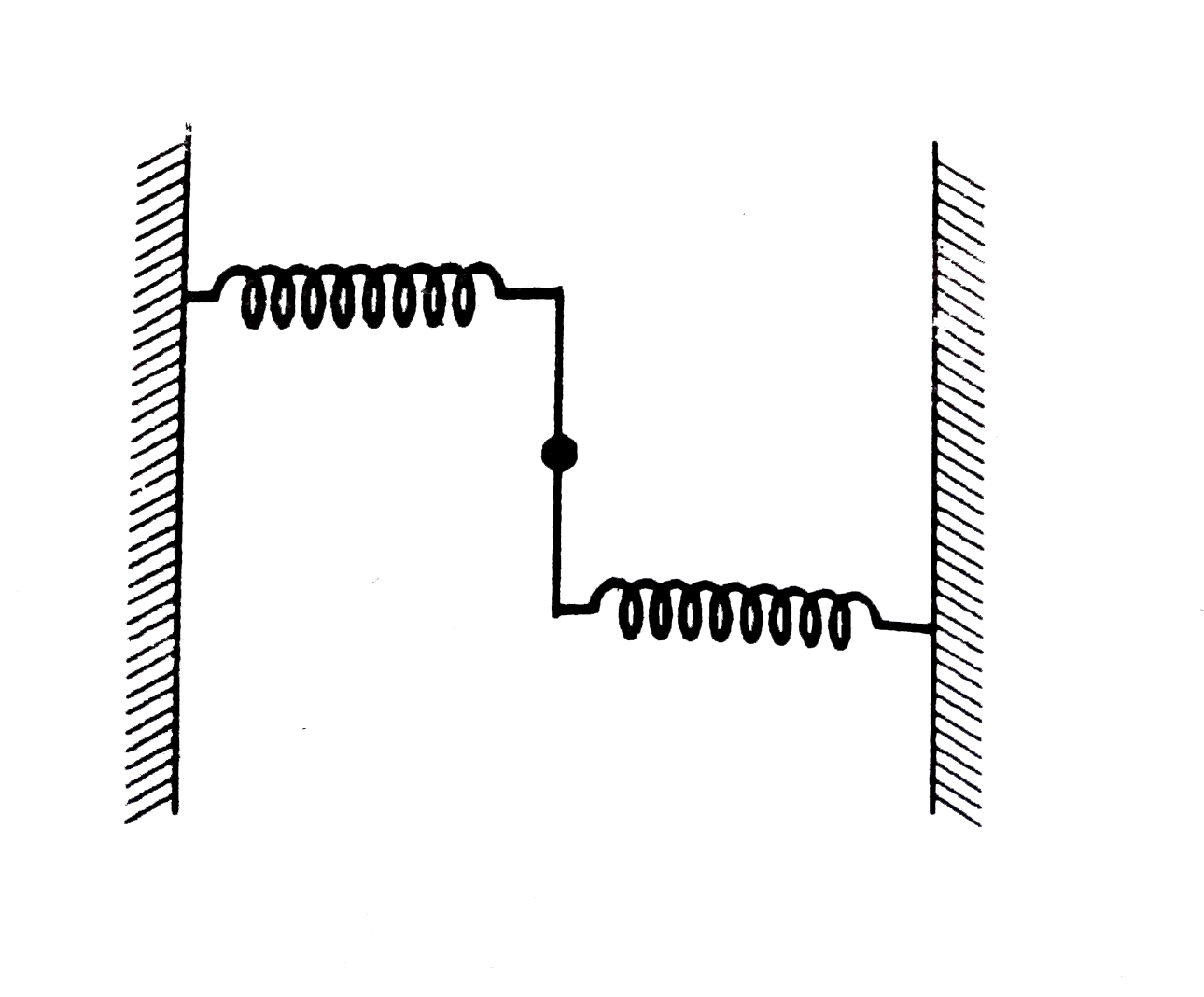 View Solution
View SolutionQuestion 66
A small block is connected to one end of a massless spring of un-stretched length 4.9 m. The other end of the spring (see the figure) is fixed. The system lies on a horizontal frictionless surface. The block is stretched by 0.2 m and released from rest at t = 0. It then executes simple harmonic motion with angular frequency ω=π3rad/s . Simultaneously at t = 0, a small pebble is projected with speed ν from point P at an angle of 45∘ as shown in the figure. Point P is at a horizontal distance of 10 m from O. If the pebble hits the block at t = 1s, the value of ν is (take g = 10 m/s2 )
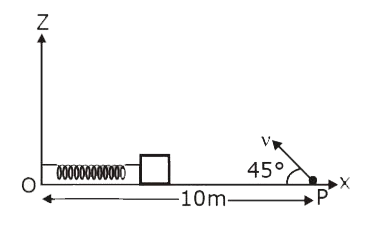 View Solution
View SolutionQuestion 70
A trolley of mass M is connected to two springs of force constant K1 and K2 as shown in the figure When the trolley is displacement from its equilibrium postion by a distance a and released , it executes S.H.M of frequency f. If it comes to rest after somtimes due to friction, the total energy dissipated as heat is (Dampling forces are weak)
 View Solution
View SolutionQuestion 75
In first case a srpings of ofrce constant K is fixed at one end a block of mass m is attahced to its other end and is placed on a horizontal frictionaless surface . In second case ,a similar springs with both ends free has a block of mass m attached to each of its ends. Each mass is streched by teh same force F in both the cases . If the mass in first released , then which of the following statement is true?View SolutionQuestion 78
A uniform cylinder of mass m, length l and cross sectional area A is suspended with its vertical from a fixed point, with the help of a massless spirng of force constant (K), The cylinder is then submerged in a liquid of density p. At equilibrium the cylinder remains submerged in the liquid with 1/4th of its volume outside the liquid, as shown in the figure. The elongation of hte spring at this point is x0. WHen the cylinder is given a slight downward push into the liquid and then released, its starts oscillating with vertical S.H.M. of small amplitude.
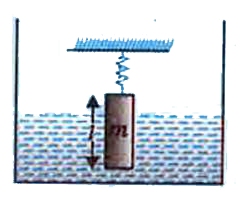
The elongation X0 produced in the springs when the syste is in equilibrium is View SolutionQuestion 79
A uniform cylinder of mass m, length l and cross sectional area A is suspended with its vertical from a fixed point, with the help of a massless spirng of force constant (K), The cylinder is then submerged in a liquid of density p. At equilibrium the cylinder remains submerged in the liquid with 1/4th of its volume outside the liquid, as shown in the figure. The elongation of hte spring at this point is x0. WHen the cylinder is given a slight downward push into the liquid and then released, its starts oscillating with vertical S.H.M. of small amplitude.
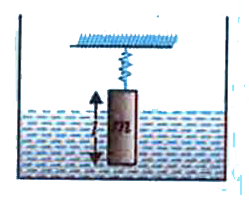
If the cyleinder is displced by a small downward displacement a from its equilibrium postion and then released , the restoring force on it will be View SolutionQuestion 80
A uniform cylinder of mass m, length l and cross sectional area A is suspended with its vertical from a fixed point, with the help of a massless spirng of force constant (K), The cylinder is then submerged in a liquid of density p. At equilibrium the cylinder remains submerged in the liquid with 1/4th of its volume outside the liquid, as shown in the figure. The elongation of hte spring at this point is x0. WHen the cylinder is given a slight downward push into the liquid and then released, its starts oscillating with vertical S.H.M. of small amplitude.
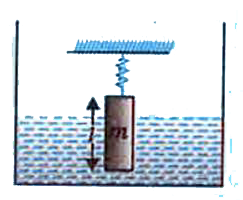
Time period of vertical S.H.M of the cylinder is View SolutionQuestion 81
A light spring of force constant k is attached to a block of mass M placed on a horizontal firctionless surface from its one end and other end is fixed to a right support. The system is executing S.H.M. of amplitude A1 and time period T1. At some instant, the block passed through the equilibrium position and a small object of mass m is placed on it. The new amplitude and time period of the system now becomes A2 and T2 respectively.
The ratio T2T1 is View SolutionQuestion 82
A light spring of force constant k is attached to a block of mass M placed on a horizontal firctionless surface from its one end and other end is fixed to a right support. The system is executing S.H.M. of amplitude A1 and time period T1. At some instant, the block passed through the equilibrium position and a small object of mass m is placed on it. The new amplitude and time period of the system now becomes A2 and T2 respectively.
The velcities of block before and after the object is placed on it are V1 and V2 respectively. Then the ratio V2/V1View SolutionQuestion 83
A light spring of force constant k is attached to a block of mass M placed on a horizontal firctionless surface from its one end and other end is fixed to a right support. The system is executing S.H.M. of amplitude A1 and time period T1. At some instant, the block passed through the equilibrium position and a small object of mass m is placed on it. The new amplitude and time period of the system now becomes A2 and T2 respectively.
The ratio A2/A1 is View SolutionQuestion 84
When a particle is mass m moves on the x− axis in a potential of the from V(x)=kx2, it performs simple harmonic motion. The corresponding thime periond is proportional to √mk, as can be seen easily asing dimensional analysis. However, the motion of a pariticle can be periodic even when its potential enem increases on both sides x=0 in a way different from kx2 and its total energy is such that the particel does not escape to infinity. consider a particle of mass m moving onthe x−axis . Its potential energy is V(x)=ω(α>0) for |x| near the origin and becomes a constant equal to V0 for |x|≥X0 (see figure)
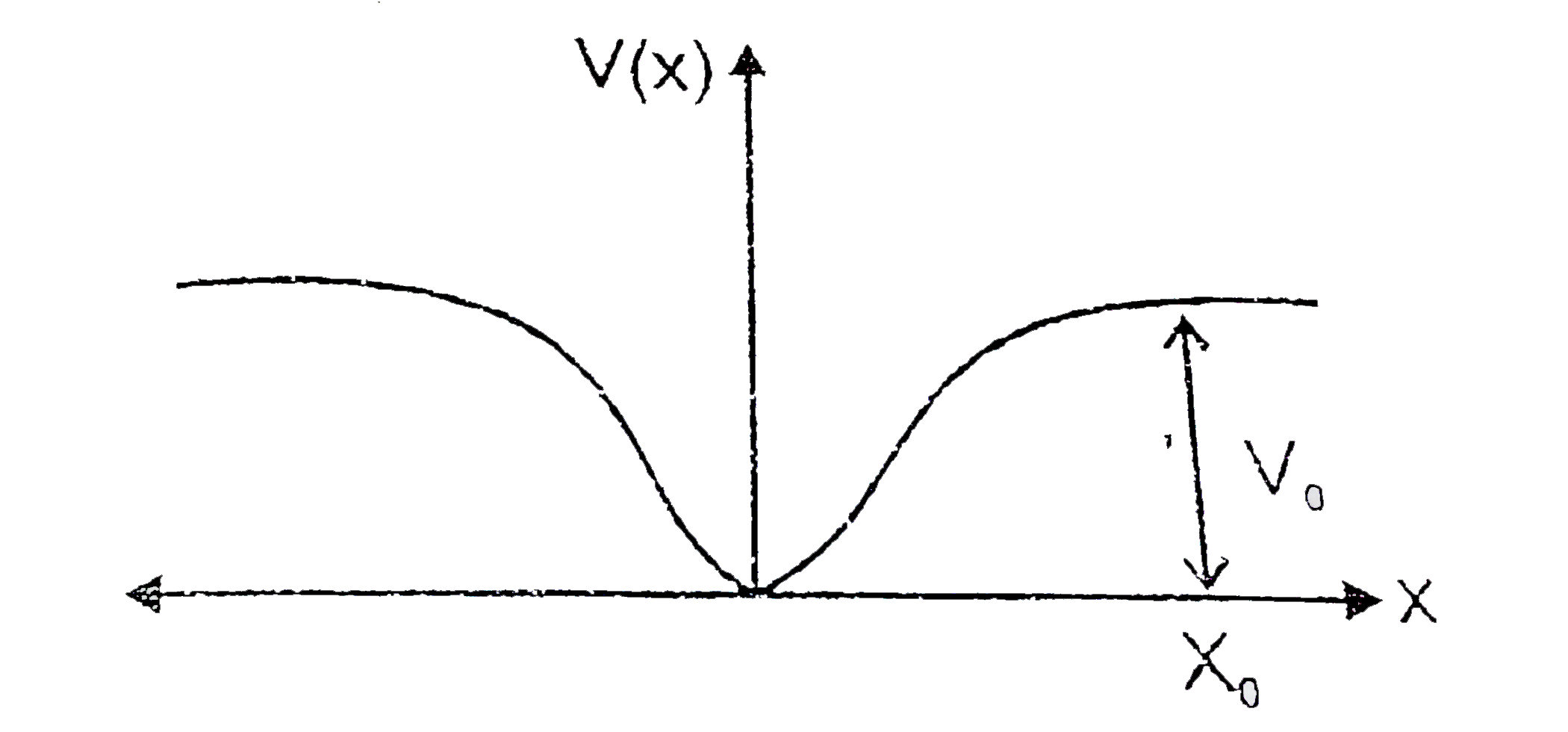
If the total energy of the particle is E, it will perform is periodic motion why if :View SolutionQuestion 85
When a particle of mass m moves on the X-axis in a potential of the form V(x)=kx2, it performs simple harmonic motion. The corresponding time period is proportional to
√mk, as can be seen easily using dimensional analysis.
However, the motion of a particle can be periodic even when its potential energy increases on both sides of x = 0 in a way different from kx2 and its total energy is such that the particle does not escape to infinity. Consider a particle of mass m moving on the X-axis. Its potential energy is V(x) =ax2(a>0) for |x| near the origin and becomes a constant equal to V0 for |x|≥X0

For periodic motion os small amplitude A . The time periodic T of this particle is proportional to View SolutionQuestion 86
When a particle of mass m moves on the X-axis in a potential of the form V(x)=kx2, it performs simple harmonic motion. The corresponding time period is proportional to
√mk, as can be seen easily using dimensional analysis.
However, the motion of a particle can be periodic even when its potential energy increases on both sides of x = 0 in a way different from kx2 and its total energy is such that the particle does not escape to infinity. Consider a particle of mass m moving on the X-axis. Its potential energy is V(x) =ax2(a>0) for |x| near the origin and becomes a constant equal to V0 for |x|≥X0
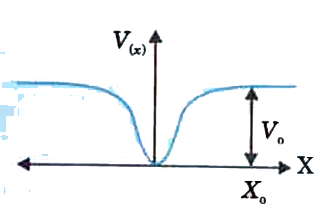
The acceleration of this particle for |X|>X0 is View SolutionQuestion 91
A particle is executing simple harmonic motion under the action of a force F with a time period 35s. When the force is changed to F', the time period of oscillation is 45s. When both the forces F and F' act simultaneously in the same direction on the body, time period in seconds in T=6a5b. COmpute the value of a + b. View SolutionQuestion 92
A spring of unstretched length 40 cm and spring constant k is attached to a block of mass 1 kg to one of its end. The other end of the spring is fixed on the top of a frictionless inclined plane of inclination θ=45∘ as shown in the figure, so that the spring extends by 3 cm. When the mass is displaced slightly and released the time period of the resulting oscillation is T. Determine the value of 5T close to nearest integer.
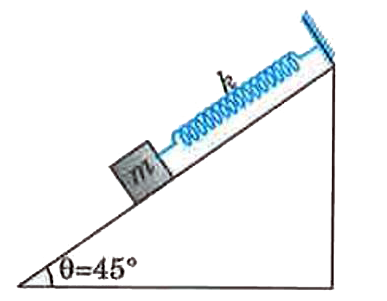 View Solution
View SolutionQuestion 93
The maximum seperation between two particles executing simple harmonic motion of the equal amplitude and same frequency along the same straight line and about the same mean position, is √3 times the amplitude of oscillation. IF the phase difference between them is ϕ, determine 2π/ϕ. View SolutionQuestion 94
A simple pendulum of time period of oscillation 2.0 s is suspended vertically. The point of suspension of the pendulum now starts moving vertically upwards with a velocity that varies with time t as v=αt where α=3.5ms−1. If the new time period of oscillation of ht pendulum is T, then find the value of 2.2T. (Take g=10ms−2) View SolutionQuestion 95
A simple pendulum suspended vertically from a rigid support is moving simple harmonically with a period of 5 s between two extreme positions A and B as shown in the figure. The angular distance between A and B is 8 cm. If it takes t seconds for the pendulum to move from position B to position C, exactly midway O and C, then find 65t.
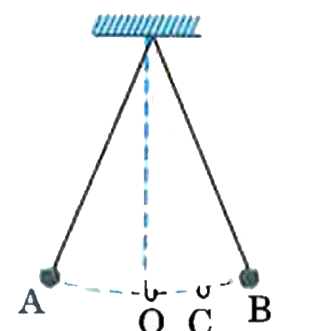 View Solution
View SolutionQuestion 100
A mass of 0.2 kg, length 1m and cross sectional area 4.9×10−7m2 is suspended from a massless wire. The mass is pulled slightly in the vertically downward direction and released. It performs simple harmonic motion of angular frequency 70 rad s−1. If the Young's modulus of the material of the wire is x×109Nm−2, find the value of x. View Solution
All Exercises from MODERN PUBLISHERS PHYSICS (HINGLISH) Class 11 PHYSICS OSCILLATIONS
- PRACTICE PROBLEMS
- PRACTICE PROBLEMS 2
- CONCEPTUAL QUESTIONS
- TOUGH & TRICKY PROBLEMS
- NCERT (ADDITIONAL EXERCISES)
- NCERT EXEMPLAR PROBLEMS SUBJECTIVE QUESTION ( SHORT ANSWER TYPE QUESTIONS )
- NCERT EXEMPLAR PROBLEMS SUBJECTIVE QUESTION (MULTIPLE CHOICE QUESTIONS (TYPE-I))
- NCERT EXEMPLAR PROBLEMS SUBJECTIVE QUESTION (MULTIPLE CHOICE QUESTIONS (TYPE-II))
- NCERT EXEMPLAR PROBLEMS SUBJECTIVE QUESTION (VERY SHORT ANSWER TYPE QUESTIONS )
- NCERT FILE (TEXTBOOK EXERCISES)
- HOTS (HIGHER ORDER THINKING SKILLS & ADVANCED LEVEL)
- REVISION EXERCISES (ADDITIONAL QUESTION )
- REVISION EXERCISES (FILL IN THE BLANKS)
- REVISION EXERCISES (LONG ANSWER QUESTIONS)
- REVISION EXERCISES (NUMERICAL PROBLEMS)
- REVISION EXERCISES (SHORT ANSWER QUESTIONS)
- REVISION EXERCISES (VERY SHORT ANSWER QUESTIONS)
- COMPETITION ASSERTION REASON TYPE QUESTIONS
- COMPETITION (INTEGER TYPE QUESTIONS)
- COMPETITION FILE (JEE (ADVANCED) FOR IIT ENTRANCE)
- COMPETITION FILE (MATCHING TYPE QUESTIONS)
- COMPETITION FILE (MATRIX MATCH TYPE QUESTIONS)
- COMPETITION FILE (MULTIPLE CHOICE QUESTION)
- COMPETITION FILE (MULTIPLE CHOICE QUESTION) BASED ON A GIVEN PASSAGE/COMPREHENSION
- COMPETITION FILE (MULTIPLE CHOICE QUESTION) JEE (MAIN) & OTHER STATE BOARDS FOR ENGINEERING ENTRANCE
- COMPETITION FILE (MULTIPLE CHOICE QUESTIONS)
- COMPETITION FILE (MULTIPLE CHOICE QUESTIONS) AIPMT/NEET OTHER STATE BOARDS FOR MEDICAL ENTRANCE
- PRACTICE TEST (FOR BOARD EXAMINATION)
- SOLVED EXAMPLES

